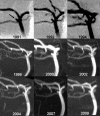Extended follow-up of unruptured intracranial aneurysms detected by presymptomatic screening in patients with autosomal dominant polycystic kidney disease
- PMID: 21551026
- PMCID: PMC3109922
- DOI: 10.2215/CJN.09731110
Extended follow-up of unruptured intracranial aneurysms detected by presymptomatic screening in patients with autosomal dominant polycystic kidney disease
Abstract
Background and objectives: Autosomal dominant polycystic kidney disease (ADPKD) patients have an increased risk for intracranial aneurysms (IAs). The importance of screening for unruptured IAs (UIAs) depends on their risks for growth and rupture.
Design, setting, participants, & measurements: ADPKD patients with UIAs found by presymptomatic screening with magnetic resonance angiography (MRA) during 1989 to 2009 were followed initially at 6 months and annually, and less frequently after demonstration of stability.
Results: Forty-five saccular aneurysms were detected in 38 patients from 36 families. Most were small (median diameter 3.5 mm) and in the anterior circulation (84%). Median age at diagnosis was 49 years. During cumulative imaging follow-up of 243 years, one de novo UIA was detected and increased in size from 2 to 4.4 mm over 144 months and two UIAs grew from 4.5 to 5.9 mm and 4.7 to 6.2 mm after 69 and 184 months, respectively. Seven patients did not have imaging follow-up. No change was detected in the remaining 28 patients. During cumulative clinical follow-up of 316 years, no aneurysm ruptured. Five patients died from unrelated causes and two were lost to follow-up after 8 and 120 months. Three patients underwent surgical clipping.
Conclusions: Most UIAs detected by presymptomatic screening in ADPKD patients are small and in the anterior circulation. Growth and rupture risks are not higher than those of UIAs in the general population. These data support very selective screening for UIAs in ADPKD patients, and widespread screening is not indicated.
Figures





References
-
- Pirson Y, Chauveau D, Torres VE: Management of cerebral aneurysms in autosomal dominant polycystic kidney disease: Unruptured asymptomatic intracranial aneurysms. J Am Soc Nephrol 13: 269–276, 2002 - PubMed
-
- Campeau NG, Huston J, III, Bernstein MA, Lin C, Gibbs GF: Magnetic resonance angiography at 3.0 Tesla: Initial clinical experience. Top Magn Reson Imaging 12: 183–204, 2001 - PubMed
-
- Unruptured intracranial aneurysms–risk of rupture and risks of surgical intervention International Study of Unruptured Intracranial Aneurysms Investigators. N Engl J Med 339: 1725–1733, 1998 - PubMed
-
- Wiebers DO, Whisnant JP, Huston J, III, Meissner I, Brown RD, Jr, Piepgras DG, Forbes GS, Thielen K, Nichols D, O'Fallon WM, Peacock J, Jaeger L, Kassell NF, Kongable-Beckman GL, Torner JC: Unruptured intracranial aneurysms: Natural history, clinical outcome, and risks of surgical and endovascular treatment. Lancet 362: 103–110, 2003 - PubMed
Publication types
MeSH terms
Grants and funding
LinkOut - more resources
Full Text Sources
Other Literature Sources
Medical

